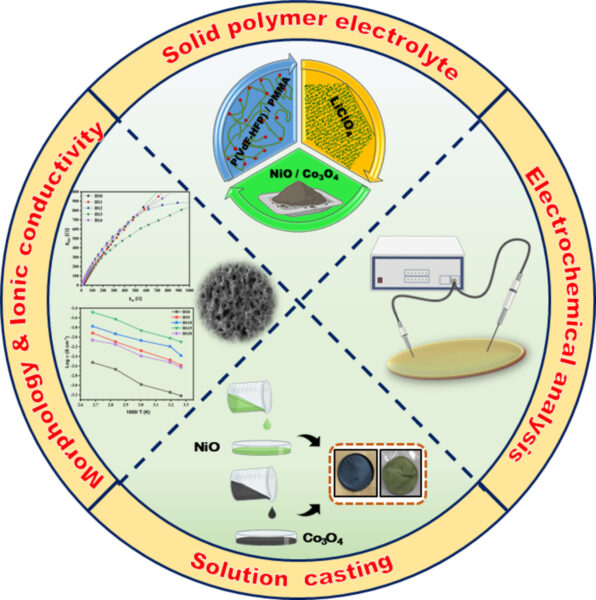Composite Polymer Electrolytes: Transforming Energy Storage

Developing high-performance solid polymer electrolytes (SPEs) represents a major leap forward for energy storage technologies, particularly lithium-ion batteries.
These materials offer enhanced ionic conductivity, improved thermal stability, and greater mechanical strength, making them ideal for next-generation energy storage solutions.
You can also read: Conductive Polymers in Supercapacitors: Innovations and Applications.
Enhancing Ion Transport in Solid Polymer Electrolytes
Composite Polymer Electrolytes (CPEs) are advanced materials made by blending PVDF-HFP, PMMA, lithium perchlorate (LiClO₄), ethylene carbonate (EC), and nanofillers. Researchers optimized the composition, incorporating 15% nanofillers such as nickel oxide (NiO) and cobalt oxide (Co₃O₄), achieving exceptional results.
These electrolytes demonstrate ionic conductivity as high as 10⁻³ S/cm and a stability window of 4.5V. Nanofillers play a key role by disrupting the polymer matrix’s crystalline structure, creating amorphous phases. This structural shift is crucial for improving ion transport, essential for efficient energy storage.

The role of passive fillers in PVDF-HFP/ PMMA blended electrolyte for energy storage applications. Courtesy of Enhancing the ion transportation on PVDF-HFP and PMMA based solid polymer electrolyte by fusing Co3O4 and NiO NPs for energy storage applications.
Ion Transport Enhanced by Nanofillers
Nanofillers like NiO and Co₃O₄ improve polymer mobility by reducing the glass transition temperature and increasing amorphous regions in the material. This enhanced amorphous structure creates pathways for faster ion transport, boosting the material’s overall efficiency.
Moreover, these nanoparticles contribute to better ion dissociation and solvation due to their surface properties and Lewis acid-base interactions. However, excessive nanofiller content causes agglomeration, which negatively impacts ionic conductivity and material uniformity.
Structural and Morphological Advances
Advanced characterization techniques such as X-ray diffraction (XRD) and Fourier transform infrared (FTIR) spectroscopy confirm the integration of nanofillers into the polymer matrix. These studies reveal how nanofillers disrupt crystalline phases, increasing amorphous regions to enhance ionic transport.
Additionally, Scanning Electron Microscopy (SEM) images demonstrate that the materials exhibit smooth and porous structures. This porous morphology facilitates ion movement, further improving the performance of these polymer electrolytes.
Improved Thermal and Dielectric Properties
Thermal stability is critical for energy storage applications, and the developed CPEs perform exceptionally well under high temperatures. The materials remain stable up to 390°C, ensuring their reliability and safety in demanding conditions.
Furthermore, the incorporation of nanofillers significantly enhances the dielectric properties of these materials. This improvement increases their energy storage capacity, making them highly suitable for applications that demand high capacitance and operational stability.
Applications in Energy Storage
These advanced polymer electrolytes offer immense potential for next-generation lithium-ion batteries, outperforming conventional electrolytes in safety, thermal stability, and mechanical strength. Their properties also make them suitable for a variety of other energy storage devices, including electrochemical and optoelectronic systems.
By offering superior performance and durability, these materials contribute to the development of more efficient and sustainable energy storage technologies.
Future Prospects for Polymer Electrolyte Technology
The integration of PVDF-HFP, PMMA, and nanofillers such as NiO and Co₃O₄ represents a significant milestone in polymer electrolyte technology. By enhancing ion transport, improving thermal stability, and boosting dielectric properties, these materials pave the way for safer and more efficient solid-state batteries.
Future research could further explore their applications across diverse energy storage systems, including fuel cells and advanced capacitors. Additionally, optimizing nanofiller composition could unlock even greater performance gains, enhancing their appeal for commercial applications.
These advancements in Composite Polymer Electrolytes mark a major step toward achieving global clean energy goals. Their high performance and sustainability align with the growing demand for innovative materials in energy storage, driving progress toward a greener future.
To read the complete study click here.
